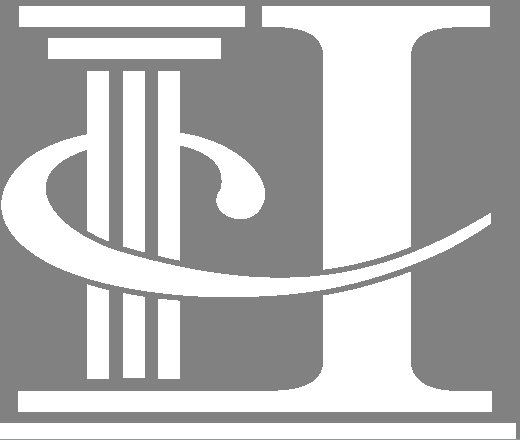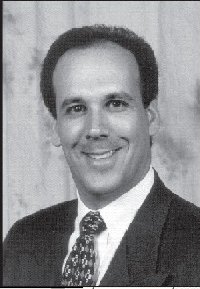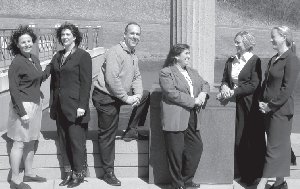
The Hennepin Lawyer
June 2003 Voume 72 Number 6
The Hennepin Lawyer is the official
publication of the Hennepin County Bar Association.
This monthly magazine is designed to educate and inform metro area
attorneys about current issues and concerns relating to their practice of
law and reporting on HCBA programs and events.
All HCBA members receive the magazine each month.
www.hcba.org

Charles Goldstein
Contributing Author
Mr.
Goldstein, a 1987 graduate of the University of Minnesota Law School,
practices family law in Minnetonka
Charles is a big fan of Ralph's. He has been working to see if some USA Concert dates can be arranged
for Ralph. Apart from the use of Ralph's lyrics at the end of the piece,
I thought it was a very interesting article and a nice
bit of background about one
of Ralph's fans in the USA ...
thanks Charles!
RALPH, ALBERT & SYDNEY
The
Holistic Law Office
The Hennepin Lawyer
June 2003
by Charles Goldstein
Numerous articles have addressed lawyers’
dissatisfaction with their life in practice.
Authors have blamed increased incivility in the practice of law,
the rise in competition, and other factors that affect our daily practice
in ways that are partially, if not wholly, beyond our control.
These articles suggest remedies such as increasing outside
interests and pro bono activities or, alternatively, exploring alternative
career paths. This article
presents several strategies for rethinking how we perceive our work, our
clients, and – indeed – our whole world.
Rather than searching for outside factors that
reduce satisfaction with our chosen career, or assuming that an
alternative career will bring greater happiness, maybe it is time we begin
to look inside ourselves and our daily practice to seek ways in which we
can improve our outlook, productivity, and happiness.
“Suffering is a consequence of one’s own action, not a
retribution inflicted by an external power…we are the authors of our own
destiny – and being the authors, we are ultimately, perhaps
frighteningly, free.” – Shantideva (8th Century)
The word “holistic” shares a common Old
English root with “heal”, “health”, “holy”, and “whole”.
A holistic outlook focuses on patterns forming a whole, rather than
breaking things down into parts and analysing the pieces (the mechanistic
outlook). As attorneys, we
tend to focus on the latter rather than the former, sometimes resulting in
wholesale neglect of the fact that we are people with multifaceted needs
and desires. By appreciating
our humanity and catering to our human qualities, we can modify the law
office into a more pleasant environment, the natural by-product being more
satisfied and productive lawyers and staff.
Our
Holistic Approach
Our office explored various strategies to
incorporate holistic aims and manifestations of the “whole person”
approach. Each of these was
designed to recognise that we are whole people, not only during the “off
hours”, but also during the full day we spend at the office.
Similar to the “mainstream” approaches of “flex time” and
“casual days”, these less mainstream approaches can be easily
implemented with tangible and positive results.

Massage
We recently initiated a weekly routine of
professional chair massages on Friday afternoons to invigorate attitudes
and smooth out the knots resulting from the stress of the week.
The benefits of massage cannot be underestimated as a means to
maintain posture and body balance, reduce muscular tension that eventually
causes structural problems, increase the flow of nutrients to the bones
and muscles, and to enjoy general relaxation and increased energy.
We are learning stretches to do during the week to help minimise or
eliminate the knots from developing in the first place.
According to local massage therapist and stress management
specialist Martin Kestin,
Stress and work are intricately linked.
Stress-related illnesses cost US industry
Between $150 billion and $300 billion
annually as assessed by absenteeism, diminished
productivity, attrition, and direct medical, legal, and insurance
fees. In addition, 40%
of worker
turnover is due to job stress. Chair
massage is an effective tool, when used regularly
to manage and reduce physical and
psychological stress in the work-place. For example, about 250 of the 400 employees of the
Ontario-based Baxter Corporation used a massage therapy programme and reduced time off for work
injuries by 25% over four years and reduced compensation claims by
$200,000 over a two-year period. (Canada Financial Times, 1996)
Those in our office have expressed enthusiasm and
gratitude for the weekly massage experience.
Walking
and Stretching
We have the good fortune to have an office
building that is situated on a large piece of property with surrounding
walking paths and a large pond. Members
of our office walk these paths together to take an effective break and re-energise. As Hippocrates said, “Walking is the best medicine.”
Our associate commented that a midday walk helped her to feel
revitalised.
When time does not allow for a midday amble,
stretching during the day is highly encouraged.
The “relaxing stretch” is a comfortable way to gradually
increase the length of a muscle and improve its flexibility.
This technique works with any tight muscle or group of muscles. Further, raising endorphin levels by stretching an otherwise
sedentary body has innumerable benefits.
Produced in the brain and other tissues, endorphins have a
structure almost identical to synthetic or plant-derived injectable
morphine. That means
endorphins can deliver the kind of pain relief and euphoria associated
with morphine. Imagine the increase in the health of an office that
stretches and exercises together, rather than smokes together! Regular stretching is encouraged and helpful stretches are
posted as constant reminders.
Posture
and Ergonomics
We have also had our office staff observed for
proper ergonomics and posture practices. Mr
Kestin provided an in-service to our office to train us in proper
ergonomics and stretching. He
states,
Ergonomics can be described as “the
worker/workstation fit”, and making the relationship
between the two as harmonious as possible.
Repetitive strain injuries
(RSI) are a direct result of the poor
relationship between repetitive movements performed daily, work tool
placements and worker posture. By
improving the fit
between these elements you minimise
the stressors on the body and reduce repetitive
strain injuries.
Ergonomic injuries stem from both physical
stresses and environmental factors. Repetitive
motion, vibration, over-exertion and poor posture are factors that can
translate to carpal-tunnel syndrome, tendonitis and back pain.
Healthy
Snacks
We keep on hand high-protein, low-fat foods for
enjoyable energy boosts, as well as a variety of herbal teas, allaying the
temptation to visit a nearby vending machine for a quick high-sugar snack. Members of our office are encouraged to bring in or request
healthy foods that not only help to maintain energy, but also provide a
focal point for socialisation in the office, rather than “stepping
out” for a cigarette.

Meditation
Once or twice a week our office takes a
“meditation break” to have a community session of meditative relief.
There is a great deal of literature supporting the tremendous
benefits that result from a regular course of meditation. These include improved relations between co-workers and
supervisors, as well as increased respect, cordiality, sociability, humour
and tolerance. In addition,
the physiological benefits of meditation have been scientifically
demonstrated and cannot be disputed.1
Why not
encourage meditation during the workday, when it is most needed, and
probably most conducive to productivity?
Sceptics might wish to read the University of
Alberta study “The Effect of the Transcendental Meditation Programme on
the Organisation of Thinking and Recall”.2
According to this study, after beginning the practice of meditation
techniques, meditation significantly increased their speed in solving
arithmetic problems accurately. Separate
from the productivity benefits such a programme, office atmosphere and
morale are boosted by this opportunity to retreat from the daily grind.
Music
Soft music in an office helps provide a calm
atmosphere for staff and stressed clientele.
Certain music has also proven effective in enhancing the
concentration and study of those exposed to musical sound waves.
Dr. George Lazanov, a Bulgarian psychiatrist, utilised music as
part of a rapid learning programme he helped develop in the mid-1960s.
While listening to classical music, his students did relaxation
exercises, and listened to an instructor recite French phrases and
translations in different voice intonations and rhythms.
After the initial session, the students took a test to see how much
they had learned. In the
class, most of the students learned 1,000 words that day – about half
the working vocabulary of a language.3
In addition, Dr. Lazanov’s students experienced
benefits that no one anticipated. Not
only did their learning become more rapid and efficient, many reported
they felt more relaxed and centred. Tensions,
stress, headaches, and other pains seemed to decrease or disappear.
Their physiological measurements seemed to back up these reports.
Studies indicate that carefully selected music can enhance
learning, memory and concentration, as well as reduce chronic pain by the
release of endorphins. Other
benefits include an increase in creativity and the reduction of stress.
Again, this is an enjoyable process that can be easily implemented
in a law office, with a productivity by-product that is significant.
Feng
Shui
Our office also recently engaged a Feng Shui expert to review and evaluate our office environment for functionality and “positive energy”. This avenue explores arrangement of office furniture and other office accoutrements with a goal of enhancing the positive feelings of those who work in the office, as well as clientele. According to local Feng Shui consultant, Nancy Setzler, “Feng Shui is powerful for any business. It can enhance its wealth and reputation, and bring harmony and joy to a work environment, all by making only subtle changes.” The modifications to our office environment have been praised by everyone, particularly an associate who was occasionally startled by those entering her office unexpectedly. Now she has a mirror arrangement that prevents this phenomenon from occurring.
Vocabulary
Enhancement
The practice of law relies heavily on
self-expression and a professional image.
Effective communication depends upon the vocabulary of the person
conveying ideas. It is more
impressive to indicate to a client that you “plan to argue a plethora of
convincing refutation” than that you’ll “bury them in paper”.
Our office reviews a list of challenging vocabulary on a weekly
basis, both to enhance the satisfaction of self-expression, as well as to
feed the overall success of our interaction with our clients, other
attorneys, the courts and the community at large.
Said Thomas Sheridan, British actor of 200 years
ago: “There is such an intimate connection between ideas and words that
whatever deficiency or fault there may be in the one necessarily affects
the other”.4 Wilfred
Funk, in Six Weeks to Words of Power, expresses it this way: “It follows
almost like a law of mathematics that the more words you know the more
clearly and powerfully you will think.
And, also, there more ideas you will invite into your mind.
The world has suddenly discovered these truths and has become
word-conscious as never before. It has awakened to the overwhelming power of words.”5
Our office has enjoyed and benefited from learning
new vocabulary and actively implementing it into our conversation with
clientele, other attorneys, the courts and each other.
Conclusion
It’s all about seeing the bigger picture and
being in touch with our humanity and our surroundings, particularly given
the meaningful work we have the honour to perform for the public.
It is sometimes too easy to lose our sense of appreciation for our
career and our very lives.
While we engage in a career dependent upon
formality and logic, we must survive and thrive in it as the human beings
we were created to be. If we
squelch the whole self in favour of the myopic approach, our
self-deception will be self-defeating, and burn-out will occur.
Instead, allowing our human light to shine will make for happier
lawyers and the clients we serve.
If
the gypsy cannot dance
In your heart you may discover
That the flame needs air to burn
And soon it will be all over.
Ralph McTell, English Folksinger
2
Donald E Miskiman, “The Effect of the Transcendental Meditation
Program on the Organization of Thinking and Recall (Secondary
Organization)” (University of Alberta, Edmonton, Alberta, Canada).
3
Denise Dennistron and Peter McWilliams, TM Book (Warner Books: NY, 1975) at 83.
4
Six Weeks to Words of Power (Pocket Books) July 1983, at 2.
5 Ibid.